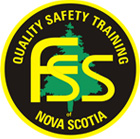Abrasive Blasting
Hazards Identified:
Dust and flying debris, skin abrasion, falling and crushing injuries
Hazard-Specific Personal Protective Equipment:
Air supplied hood with breathable air, hearing protection, heavy coveralls or apron, heavy gloves
Hazard-Specific Training:
Training by competent person in the use of the abrasive blasting equipment and in the use and maintenance of the breathing air system
Safe Work Practice:
A #2 First Aid Kit and an eyewash station must be on site.
Employees using abrasive blasting equipment must be qualified to do so. Do not use this equipment until you have been properly instructed.
If possible, use only manufactured, processed abrasive media that has been approved for abrasive blast cleaning. Note that special precautions are required for the use of silica sand—contact the Occupational Hygienist, Occupational Health and Safety Section for additional precautions.
Check the surface coating to be blasted for toxic substances. Protect operator and bystanders from toxic dust and debris.
Check the breathing air source for the air supplied hood. Use only an ambient air type breathing pump (do not use compressed air). The source air must be located in a dust and contamination free environment. Check condition of the pump inlet and outlet air filters and replace as required.
Inspect the air supplied hood and replace any worn, damaged or excessively dirty components. Make sure all of the components including the cape, inner and outer lenses, breathing hose, air control valve and gaskets are in good operating condition.
Inspect the condition of the abrasive blasting machine. Check the pop-up valve and gasket, piping and compression coupling fittings. Replace excessively worn or damaged parts and tighten all fittings. Check the air filtering system and moisture separator as per manufacturer’s specifications.
Inspect blast hose nozzle and hose connections for wear or damage and replace as required.
Ensure all exhaust fans are in good working order.
Ensure all work is secured or securely placed before starting blasting operation.
Regulations, Standards and References
Occupational Safety General Regulations, Canadian Standards: CAN/CSA-Z94.4-93, ‘Selection, Use, and Care of Respirators
